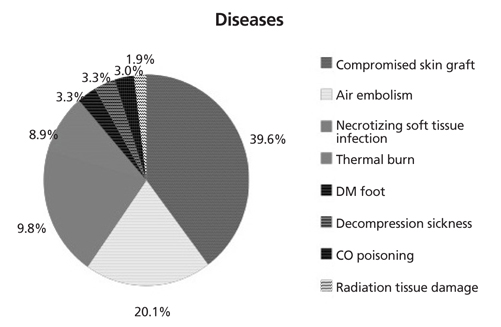J Korean Med Assoc.
2014 Jul;57(7):601-606. 10.5124/jkma.2014.57.7.601.
Clinical applications and contemporary trends of hyperbaric oxygen therapy in Korea
- Affiliations
-
- 1Department of Emergency Medicine, Chungnam National University College of Medicine, Daejeon, Korea.
- 2Department of General Surgey, Tongyeong Segyero Hospital, Tongyeong, Korea.
- 3Department of Emergency Medicine, Yonsei University Wonju College of Medicine, Wonju, Korea.
- 4Department of Emergency Medicine, Ajou University College of Medicine, Suwon, Korea. flyingguy@ajou.ac.kr
- KMID: 2194896
- DOI: http://doi.org/10.5124/jkma.2014.57.7.601
Abstract
- Hyperbaric oxygen therapy (HBOT) is approved in the United States for 14 accepted indications, which are approved by the HBOT committee of the Undersea and Hyperbaric Medical Society and by the Food and Drug Administration. These indications are also used worldwide. HBOT is a mode of medical treatment in which the patient is situated in an enclosed pressure chamber and breathes 100% oxygen at a pressure greater than 1 atmosphere absolute (ATA), with the usual therapeutic pressure set at greater than 1.4 ATA. In South Korea, an expanded knowledge base and formalized education in HBOT do not exist, and numerous HBOT devices are old and nearing the cessation of operation, although HBOT has undergone refinement, with an increased understanding of mechanisms of action and clinical applications. Furthermore, there is no specific board certification of HBO competence for emergency, critical care, and surgical physicians and technicians in South Korea. We summarize the existing literature on the uses of HBO with the aim of enhancing the understanding of this therapeutic technique.
Keyword
MeSH Terms
Figure
Reference
-
1. Vincent JL, Abraham EA, Moore FA, Kochanek PM, Fink MP. Textbook of critical care. 6th ed. Philadelphia: Elsevier Saunders;2011. p. 373–375.2. Lee HY. Hyperbaric oxygen therapy. In : Lee BK, editor. Textbook of clinical procedures. Seoul: Koonja;2012. p. 955–971.3. Leach RM, Rees PJ, Wilmshurst P. Hyperbaric oxygen therapy. BMJ. 1998; 317:1140–1143.
Article4. Tibbles PM, Edelsberg JS. Hyperbaric-oxygen therapy. N Engl J Med. 1996; 334:1642–1648.
Article5. Undersea and Hyperbaric Medical Society. Indications for hyperbaric oxygen therapy [Internet]. Durham: Undersea and Hyperbaric Medical Society;2011. cited 2013 Jul 1. Available from: http://membership.uhms.org/?page=Indications.6. Shank ES, Muth CM. Decompression illness, iatrogenic gas embolism, and carbon monoxide poisoning: the role of hyperbaric oxygen therapy. Int Anesthesiol Clin. 2000; 38:111–138.
Article7. Catron PW, Dutka AJ, Biondi DM, Flynn ET, Hallenbeck JM. Cerebral air embolism treated by pressure and hyperbaric oxygen. Neurology. 1991; 41:314–315.
Article8. Boykin VJ. hyperbaric oxygen therapy: a physiological approach to selected problem wound healing. Wounds. 1996; 8:183–198.9. Cohn GH. Hyperbaric oxygen therapy: promoting healing in difficult cases. Postgrad Med. 1986; 79:89–92.10. Kindwall EP, Gottlieb LJ, Larson DL. Hyperbaric oxygen therapy in plastic surgery: a review article. Plast Reconstr Surg. 1991; 88:898–908.11. Riseman JA, Zamboni WA, Curtis A, Graham DR, Konrad HR, Ross DS. Hyperbaric oxygen therapy for necrotizing fasciitis reduces mortality and the need for debridements. Surgery. 1990; 108:847–850.12. Sahni T, Singh P, John MJ. Hyperbaric oxygen therapy: current trends and applications. J Assoc Physicians India. 2003; 51:280–284.13. Dempsey J, Hynes N, Smith T, Sproat JE. A cost effectiveness analysis of hyperbaric therapy in osteoradionectosis. Can J Plast Surg. 1997; 5:221–229.14. Cianci P, Sato R. Adjunctive hyperbaric oxygen therapy in the treatment of thermal burns: a review. Burns. 1994; 20:5–14.
Article15. Cramer FS. Care of the injured soldier: a medical readiness role for clinical hyperbaric oxygen therapy. Mil Med. 1985; 150:372–375.
Article16. Hart GB. Exceptional blood loss anemia. Treatment with hyperbaric oxygen. JAMA. 1974; 228:1028–1029.
Article17. Calhoun JH, Cobos JA, Mader JT. Does hyperbaric oxygen have a place in the treatment of osteomyelitis? Orthop Clin North Am. 1991; 22:467–471.
Article18. Upton PG, Yamaguchi KT, Myers S, Kidwell TP, Anderson RJ. Effects of antioxidants and hyperbaric oxygen in ameliorating experimental doxorubicin skin toxicity in the rat. Cancer Treat Rep. 1986; 70:503–507.
- Full Text Links
- Actions
-
Cited
- CITED
-
- Close
- Share
- Similar articles
-
- Treatment of radiation-induced cystitis with hyperbaric oxygen
- A Basic Survey for Regional Capability of Hyperbaric Oxygen Therapy to Multiple Fire Victims
- Early experience of hyperbaric oxygen therapy in radiation-induced cystitis
- A Review of Clinical Applications of Hyperbaric Oxygen Therapy in Psychiatric Disorders
- Hyperbaric Oxygen Therapy in Pyoderma Gangrenosum


